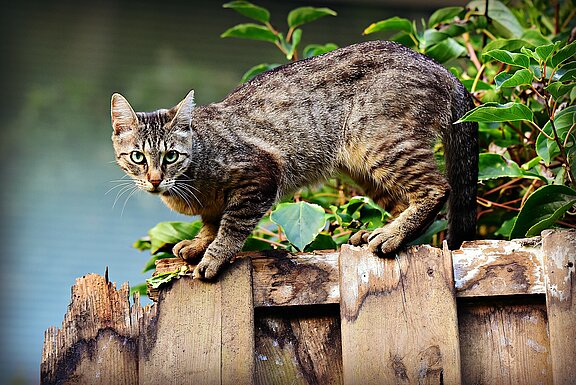At the end of June, the State Veterinary Institute in Puławy, Poland, reported suspected cases of infection with the highly pathogenic avian influenza virus (HPAIV) of subtype H5N1 in cats from various parts of the country. Numerous cats are said to be affected; by mid-July, 47 samples had been examined, 29 of them with positive results. Some of the animals showed severe symptoms of the disease, such as pneumonia and central nervous disorders, which in some cases were fatal. Affected were both, outdoor cats and those that were kept indoors all the time.
Initial sequence analyses of the H5N1 viruses detected among the cats revealed that they were HPAIV H5N1 of clade 2.3.4.4.b. Closely related viruses have been detected in wild birds and poultry in Europe since late 2022. The genome sequences of the feline viruses published so far are very closely related. There is no evidence of cat-to-cat or cat-to-human transmission.
The currently available information points to a single or very few, as yet not clearly identified, source(s) of infection. Besides direct or indirect contact with infected wild birds and their excreta, another possible source would be food. Investigations to identify the source(s) of infection are ongoing by the competent Polish authorities.
As HPAIV H5N1 clade 2.3.4.4.b is also circulating in Germany, individual cases of infection in cats (e.g. through contact with infected wild birds) cannot be completely ruled out. France and Italy have already reported such individual cases. In Poland, on the other hand, it seems to be an unusual supra-regional cluster.
Regardless of the results of the epidemiological investigations in Poland, the general recommendation from an infection biology point of view is not to feed cats with raw meat and, especially in areas with increased evidence of HPAIV H5N1 in wild birds, to take care to minimise access to wild birds, i.e. to restrict free access accordingly.
Infected mammals
Cats, both domestic cats and large cats such as tigers, lions and pumas, are susceptible to avian influenza viruses of subtype H5N1. Reports of infected big cats are available from various countries, whereby the feeding of infected birds (poultry) could not infrequently be identified as the source of infection (e.g. Thailand, China). In the same way, cats and big cats become infected by eating infected wild birds, for example in North America (wild pumas).
So far, there is no evidence of H5N1 in domestic animals in Germany. However, highly pathogenic H5 viruses have been detected in recent years in a total of 17 wild foxes, one otter, one coati kept in a zoo, three wild seals and one grey seal from a seal breeding station, all of which were probably infected through contact with wild birds, because all viruses detected in mammals so far were most closely related to viruses from wild birds from the same region.
The current global spread and massive presence of HPAIV H5N1 in wild birds also leads to an increase in contacts of wild carnivores with infected birds, which in turn explains the worldwide increase in cases of infected mammals. In the vast majority of cases, these are single infection events without further spread within the affected species.
Adaptation of the virus to mammals
In the course of virus replication in the mammalian host, HPAIV can adapt, even in wild carnivores. These adaptations are characterised by mutations in the viral genome. So far, however, only single mutations have been detected, which at best indicate a partial adaptation. In this respect, however, these viruses are not passed on from mammal to mammal. Animals are dead-end hosts for the virus because it does not have the required complete set of mutations. An exception is the case of an infection in a mink farm in Spain in autumn 2022, where there was spread in the herd by mink-to-mink transmission. There, however, the virus was eliminated by killing all animals; humans had not become infected.
In the cat cases in Poland, the H5N1 viruses sequenced there also show the first individual adaptation mutations. More extensive mutations are absent in the sequences examined in Poland. Nevertheless, the cases in Poland should be followed closely due to the atypical accumulation.
For the public in general, according to a risk assessment by the European Centre for Disease Prevention and Control, ECDC, there is currently only a very low risk of infection, if any.
The increasing trend of HPAI cases in wild carnivorous mammals is currently due to the high number of infected wild birds and not to virus transmission between mammals.
However, any HPAI virus infection that becomes known in mammals must be investigated very closely and, in particular, the virus genomes must be analysed to rule out the possibility that more advanced adaptive mutations have already developed.
Unfortunately, possibilities for intervention in wild bird populations that would lead to an interruption of infection chains are currently very limited. However, in the event of mass mortality of wild birds due to HPAI, attempts should be made to collect the carcasses of dead birds as quickly as possible and to dispose of them harmlessly. This should only be done by trained, authorised and appropriately protected personnel. Sites where dead waterfowl and gulls are found should therefore be reported to the competent authorities (public order office, veterinary office).


